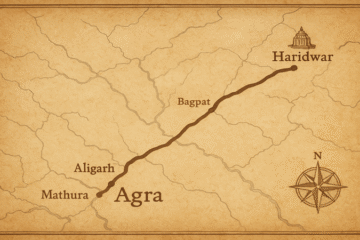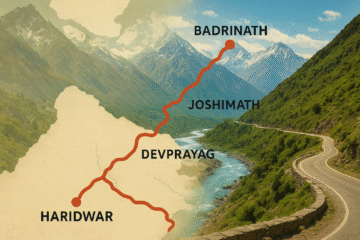
Table of Contents
Top 5 Most Famous Temples in Uttarakhand You Must Visit: A Journey Through Devbhoomi
Uttarakhand, nestled in the majestic Himalayas, is aptly known as “Devbhoomi,” the Land of the Gods. This northern Indian state is a spiritual haven, home to countless ancient temples and sacred sites that draw pilgrims and tourists alike. The serene landscapes, snow-capped peaks, and gushing rivers provide a breathtaking backdrop to these revered sanctuaries, making a visit here not just a religious experience but also a deeply enriching one.
Among the myriad of temples scattered across its diverse terrain, five stand out for their historical significance, profound spiritual aura, and architectural grandeur. These temples, deeply embedded in Hindu mythology and tradition, offer a unique glimpse into India’s rich religious heritage. Let’s embark on a journey to explore the top 5 most famous temples in Uttarakhand that you simply must visit.

1. Kedarnath Temple: Abode of Lord Shiva in the Himalayas
- Location: Rudraprayag District, Uttarakhand
- Deity: Lord Shiva (one of the 12 Jyotirlingas)
- Significance: Part of the Char Dham and Panch Kedar pilgrimage circuits.
Perched at an astounding altitude of 3,583 meters amidst the Garhwal Himalayas, the Kedarnath Temple is undoubtedly one of the holiest and most revered shrines in India. Dedicated to Lord Shiva, it is one of the twelve Jyotirlingas (lingam of light) and a pivotal part of the sacred Char Dham Yatra (Yamunotri, Gangotri, Kedarnath, and Badrinath) and the Panch Kedar pilgrimage.
History and Mythology: The origins of Kedarnath are steeped in ancient legends. According to Hindu mythology, the temple was originally built by the Pandavas after the Mahabharata war to atone for their sins of killing their kith and kin. Lord Shiva, however, tried to avoid them, taking refuge in the form of a bull (Nandi). When Bhima, one of the Pandava brothers, recognized him, Shiva dived into the ground, leaving his hump on the surface at Kedarnath. The remaining parts of his body are believed to have appeared at four other locations, forming the Panch Kedar: Tungnath (arms), Rudranath (face), Madhyamaheshwar (navel), and Kalpeshwar (hair). The current stone temple is believed to have been built by Adi Shankaracharya in the 8th century AD, adjacent to an even older temple.
Architectural Grandeur: The Kedarnath Temple is a marvel of ancient Indian architecture. Constructed with extremely large, heavy, and evenly cut grey stone slabs, its conical rock formation inside the temple is worshipped as Lord Shiva in his Sadashiva form. The temple stands on a large rectangular platform, defying the harsh weather conditions of the Himalayas for centuries. Its imposing structure, set against a backdrop of snow-covered peaks, creates a truly awe-inspiring sight.
Pilgrimage Experience: Reaching Kedarnath requires a challenging but rewarding 16-17 km trek from Gaurikund. The journey is arduous, often accompanied by unpredictable weather, but the spiritual fervor of devotees and the breathtaking natural beauty make it an unforgettable experience. The temple remains open for only about six months a year, from late April/early May to October/November, due to heavy snowfall. During the winter months, the idol of Lord Kedarnath is shifted to Ukhimath for worship.

2. Badrinath Temple: The Divine Abode of Lord Vishnu
- Location: Chamoli District, Uttarakhand
- Deity: Lord Vishnu (one of the 108 Divya Desams)
- Significance: Part of the Char Dham pilgrimage circuit.
Nestled between the Nar and Narayan mountain ranges on the banks of the Alaknanda River, the Badrinath Temple is another cornerstone of the Char Dham Yatra and one of the 108 Divya Desams (holy abodes of Lord Vishnu). Dedicated to Lord Vishnu, in his form as Badrinarayan, this temple holds immense significance for Vaishnavites across the globe.
History and Mythology: The Badrinath temple’s history is deeply intertwined with Adi Shankaracharya, who is believed to have established the temple in the 8th century AD. Legend has it that Shankaracharya discovered a black stone idol of Lord Badrinarayan made of Saligram stone in the Alaknanda River. He initially enshrined it in a cave near the Tapt Kund hot springs. In the 16th century, the King of Garhwal moved the idol to its current location. The name “Badarinath” is derived from “Badari,” a type of wild berry, believed to be the form Goddess Lakshmi took to shade Lord Vishnu during his penance in these mountains.
Architectural Grandeur: The temple’s architecture is typical of North Indian style, with a distinctive conical shape. The main deity, a one-meter-high image of Lord Badrinarayan, is exquisitely sculpted in black stone and depicts Lord Vishnu seated in a meditative pose (Padmasan). The temple complex also houses shrines dedicated to other deities like Kuber, Narada Muni, Uddhava, Nar, and Narayan.
Pilgrimage Experience: Badrinath is relatively more accessible than Kedarnath, with good road connectivity. The temple, like Kedarnath, opens in late April/early May and closes in October/November. Pilgrims often take a dip in the natural hot spring of Tapt Kund, believed to have medicinal properties, before entering the temple. The serene surroundings, with the Neelkanth peak towering in the background, add to the spiritual ambiance. Nearby attractions include the Mana Village (India’s last village before the Tibetan border), Vyas Gufa (where Ved Vyas is believed to have dictated the Mahabharata), and Vasudhara Falls.

3. Gangotri Temple: Source of the Holy Ganges
- Location: Uttarkashi District, Uttarakhand
- Deity: Goddess Ganga
- Significance: Part of the Char Dham pilgrimage circuit, origin of the Bhagirathi River (Ganges).
Dedicated to Goddess Ganga, the Gangotri Temple marks the sacred spot from where the Bhagirathi River, the source stream of the holy River Ganga, descends from the Himalayas. Situated at an altitude of 3,100 meters, this temple is an integral part of the Char Dham Yatra and holds immense reverence for Hindus.
History and Mythology: The temple’s history traces back to the 18th century when it was built by Gorkha General Amar Singh Thapa. According to Hindu mythology, it was here that King Bhagiratha performed severe penance to Lord Shiva to bring the River Ganga down to earth to cleanse the sins of his ancestors. Lord Shiva, impressed by his devotion, released the mighty river from his matted hair, and it is believed to have first touched earth at Gangotri. The actual glacial source of the Ganga, Gaumukh, is a challenging trek of about 19 km further from the temple.
Architectural Grandeur: The Gangotri Temple is a relatively modest structure built of white granite. It stands on the left bank of the Bhagirathi River, amidst the stunning natural beauty of deodar and pine trees. Near the temple is the Bhagirath Shila, a holy rock where King Bhagiratha is said to have worshipped Lord Shiva.
Pilgrimage Experience: Gangotri is accessible by road, though the journey can be challenging due to mountainous terrain. The temple typically opens on Akshaya Tritiya (April/May) and closes on Diwali (October/November). Pilgrims often take a holy dip in the icy waters of the Bhagirathi River, believed to cleanse sins. The tranquil surroundings and the powerful presence of the roaring river create a profound spiritual atmosphere.

4. Yamunotri Temple: Abode of Goddess Yamuna
- Location: Uttarkashi District, Uttarakhand
- Deity: Goddess Yamuna
- Significance: Part of the Char Dham pilgrimage circuit, source of the Yamuna River.
The Yamunotri Temple, located in the westernmost part of the Garhwal Himalayas at an altitude of 3,293 meters, is dedicated to Goddess Yamuna, the river goddess. It is the first stop on the Char Dham Yatra, symbolizing the origin of the Yamuna River.
History and Mythology: The Yamunotri temple was built by Maharani Guleria of Jaipur in the 19th century and later rebuilt after being damaged by an earthquake. According to Hindu mythology, Yamuna is the daughter of Surya (the Sun God) and the twin sister of Yama (the God of Death). It is believed that a dip in the holy waters of the Yamuna River can cleanse all sins and protect one from the fear of untimely death. The temple is also associated with Sage Asit Muni, who lived here and bathed daily in both the Ganges and Yamuna. When he became old and unable to travel to Gangotri, a stream of the Ganges miraculously appeared near Yamunotri for him.
Architectural Grandeur: The Yamunotri Temple is a relatively simple shrine, built with black marble for the main deity, Goddess Yamuna. Its sloping roofs are designed to withstand heavy snowfall. Near the temple are several hot water springs, the most important being Surya Kund. Devotees often cook rice and potatoes in these hot springs as an offering to the deity, taking the cooked food back as prasada. A sacred rock pillar known as Divya Shila is worshipped before entering the temple.
Pilgrimage Experience: Reaching Yamunotri involves a 6 km trek from Janki Chatti. The trek offers picturesque views of waterfalls and verdant valleys. Ponies and palanquins are available for those who prefer not to walk. The temple usually opens on Akshaya Tritiya and closes on Yama Dwitiya (the second day after Diwali). The unique ritual of cooking food in the hot springs and the serene beauty of the surroundings make the Yamunotri pilgrimage a distinctive spiritual experience.

5. Jageshwar Dham: A Cluster of Ancient Temples
- Location: Almora District, Kumaon Himalayas, Uttarakhand
- Deity: Lord Shiva (numerous temples)
- Significance: Group of ancient temples, believed to be one of the 12 Jyotirlingas.
Unlike the individual grandeur of the Char Dham temples, Jageshwar Dham is a remarkable complex of over 125 ancient Hindu temples, dating back to the 7th to 12th centuries AD. Situated in a serene valley amidst dense deodar forests, about 35 km from Almora, it is considered one of the holiest places in the Kumaon region and is dedicated to Lord Shiva.
History and Mythology: The construction of these temples is attributed primarily to the Katyuri and Chand dynasties. While many believe it to be one of the 12 Jyotirlingas, its mythological significance is also tied to Lord Shiva’s arrival here for meditation. The site is a treasure trove of archaeological and architectural wonders, with inscriptions and ancient carvings that speak of its rich past. It is believed that visiting Jageshwar helps cleanse sins and grants moksha (liberation).
Architectural Grandeur: The temples at Jageshwar Dham exhibit diverse architectural styles, predominantly the Nagara style. The main temple, Jaganath (also known as Jageshwar), houses the revered Shivalinga. Other prominent temples in the complex include the Maha Mrityunjay Temple, Dandeshwar Temple, Nav Durga Temple, Kuber Temple, and Surya Temple. Each temple boasts unique carvings and designs, reflecting the craftsmanship of different periods. The site is often referred to as an “open-air museum” due to the sheer number and variety of its ancient structures.
Pilgrimage Experience: Jageshwar Dham offers a tranquil and immersive spiritual experience away from the bustling crowds of other popular pilgrimage sites. The serene ambiance, coupled with the intricate architecture and historical significance of the temples, makes it a captivating destination for devotees and history enthusiasts alike. It is accessible by road and can be visited throughout the year, although the summer and post-monsoon months offer the most pleasant weather.
Planning Your Pilgrimage: Essential Tips
Visiting these revered temples in Uttarakhand requires careful planning, especially due to their high-altitude locations and specific opening/closing seasons.
- Best Time to Visit: The ideal time to visit the Char Dham temples (Kedarnath, Badrinath, Gangotri, Yamunotri) is generally from May to June and September to October. During these months, the weather is pleasant, and the routes are typically clear of snow and landslides. Jageshwar Dham can be visited throughout the year, with March to June and September to November being particularly pleasant. Avoid the monsoon season (July-August) due to heavy rainfall and the risk of landslides.
- Accommodation: While basic accommodations are available near most temples, it’s advisable to book in advance, especially during peak pilgrimage seasons. Larger towns like Rishikesh, Haridwar, Uttarkashi, and Joshimath offer a wider range of hotels and guesthouses.
- Connectivity: Rishikesh and Haridwar are major railway hubs and popular starting points for pilgrimages. Jolly Grant Airport in Dehradun is the nearest airport. Road connectivity to these temples has improved significantly, but some stretches still require treks.
- Physical Fitness: The treks to Kedarnath and Yamunotri require a reasonable level of physical fitness. It’s advisable to prepare with light exercises and walks beforehand. Consult your doctor, especially if you have any health conditions, as high altitudes can pose challenges.
- Respect Local Customs: Dress modestly when visiting temples and respect local customs and traditions.
- Carry Essentials: Pack warm clothing, comfortable trekking shoes, rain gear, basic medicines, and a first-aid kit. Carry sufficient water and energy snacks, especially during treks.
Uttarakhand’s temples are more than just places of worship; they are repositories of ancient wisdom, cultural heritage, and spiritual solace. A journey to these sacred sites is not merely a trip but a profound experience that rejuvenates the soul and connects one with the divine amidst the unparalleled beauty of the Himalayas. Whether you seek spiritual enlightenment, historical insight, or simply the tranquility of nature, these top 5 famous temples offer an unforgettable pilgrimage that will leave an indelible mark on your heart.


